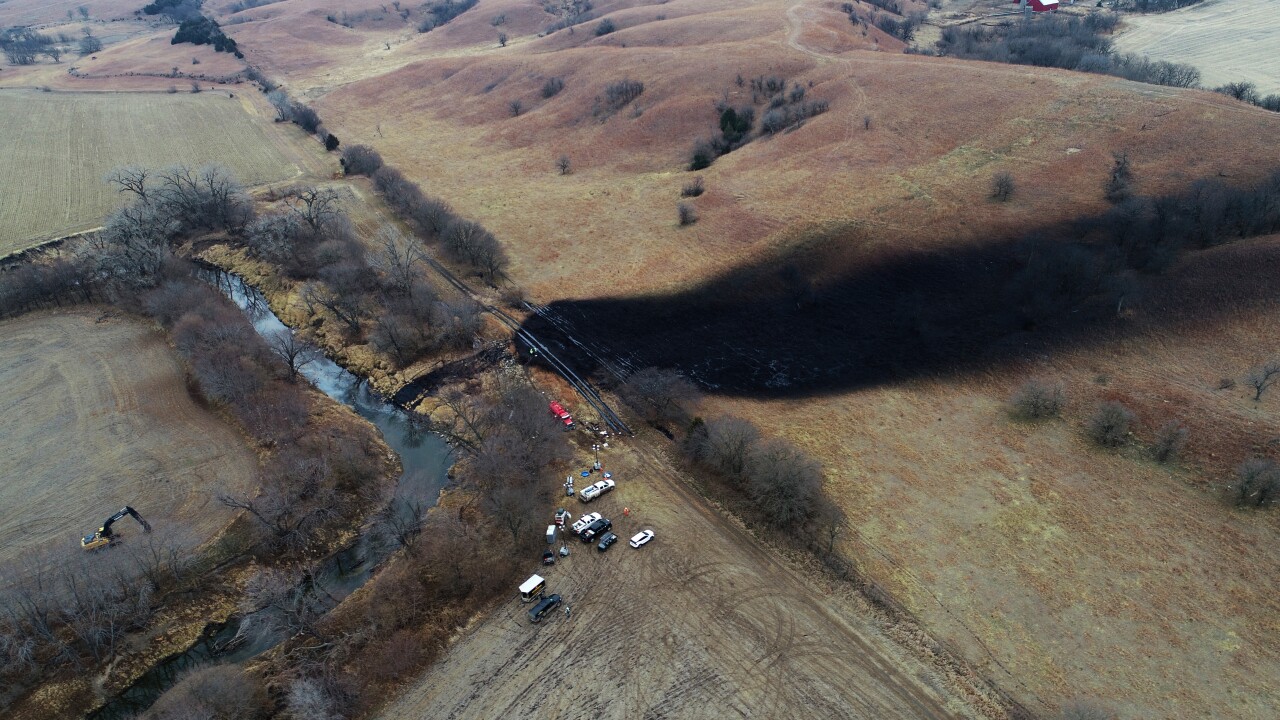KANSAS CITY, Mo. — Waterways in Washington County, Kansas, that were impacted last month when more than half a million gallons of oil leaked from a ruptured section of the Keystone Pipeline in northern Kansas are recovering.
The Kansas Department of Health and Environment announced Wednesday that water testing on Mill Creek showed “a decrease in the concentration of contaminants over time” and there was “a downward trend in contaminants” on the Little Blue River.
The U.S. Environmental Protection Agency estimated that the leak impacted surface water at least 3 1/2 miles downstream, leaving a visible sheen, significantly affecting fish and wildlife and staining vegetation near the broken section of pipeline.
The health department began sampling Mill Creek after an estimated 14,000 barrels of oil, or 588,000 gallons, began to leak Dec. 7 from the broken section of pipeline, contaminating nearby land and waterways.
The oil spill caused the Keystone Pipeline’s owner — TC Energy, a massive Canadian energy company — to shut down the nearly 2,700-mile pipeline, which bisects the U.S. from the Texas Gulf Coast to Canada. It runs through Texas, Oklahoma, Kansas, Nebraska and the Dakotas.
KDHE issued a steam advisory on Dec. 9, alerting residents to avoid entering or allowing livestock and pets to enter Mill Creek in the area of the spill. That advisory remains in effect.
Contractors for TC Energy who are cleaning up spilled oil — a diluted type of crude oil known as bitumen — conduct daily water and soil sampling, which is reviewed and analyzed by KDHE staff.
TC Energy claims nearly 12,000 barrels of oil, as of Jan, 2, and more than 28,500 barrels of oil and water, as of Jan. 10, have been recovered during cleanup operations, but it’s a messy process.
“Bitumen is a heavy grade of crude oil that is safely diluted for transportation down the pipeline,” Randy Carlson, PhD, Geologist and Director of Environmental Remediation at KDHE said. “Without dilution, it would not flow through a pipeline efficiently.”
TC Energy announced Jan. 3 that it was working to divert Mill Creek upstream of the spill with water pumps and bypass lines to a location downstream to help prevent ongoing contamination and speed up the cleanup process.
“Specially constructed earthen dams have been effective at containing spilled material,” the KDHE said in Wednesday’s update. “However, trace amounts of petroleum contaminants have been detected downstream. The diversion of surface water around the impacted area will reduce the chance of further impacts downstream.”
The spill does not impact the public water supply, because there are none present on the Little Blue River in the affected areas. TC Energy is providing water and water testing for landowners in the area, the KDHE said.
The EPA, a federal agency responsible for protecting natural resources and responding to environmental calamities, announced Monday that TC Energy had entered into a cleanup agreement, resulting from violations of the Clean Water Act that created “an imminent and substantial threat to human health and the environment.”
“EPA is grateful to the hundreds of EPA and other federal, state, and local agency personnel who quickly responded to this emergency,” EPA Region 7 Administrator Meg McCollister said in a statement. “The federal government and the state of Kansas are committed to a thorough cleanup and restoration of the impacted area.”
The EPA’s cleanup order requires TC Energy “to recover oil and oil-contaminated soil and vegetation and contain the further spread of oil in Mill Creek” under agency oversight.
The U.S. Department of Transportation also planned to investigate some aspects of the pipeline rupture.
The section of pipeline that ruptured last month was built in 2011.
Frigid late-December temperatures slowed the cleanup process, which involved hundreds of people, but the pipeline was cleared to resume operations Dec. 23 amid the cold snap.
TC Energy announced Dec. 29 that it had resumed all pipeline operations.
The oil spill is the largest in the pipeline's history in the U.S., eclipsing the 383,000 gallons that spilled when a section in North Dakota ruptured in October 2019.
Keystone is the most leak-prone pipeline operating in the U.S.
Concerns about such spills led President Biden to shutdown plans for Keystone Pipeline XL, which would have expanded the Keystone system.





